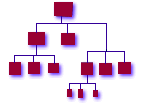


|

|
|
home | sitemap | abstract | introduction | chaos | thinking | checklist | migrating | recovery pushpull | cost | career | workshop | isconf | list_and_community | papers | references |
Migrating From an Existing Infrastructure
Think of a migration as building a new enterprise cluster, and migrating your old hardware into the new cluster, one node at a time. The first infrastructure we used to develop this model was in fact one that had started chaotically, as four desktop machines that were administered by the application developers who sat in front of them. As the internal application they developed became successful, the infrastructure grew rapidly, and soon consisted of 300 machines scattered worldwide. At the time we embarked on this effort, these 300 machines were each unique, standalone hosts -- not even DNS or NIS were turned on. This state of affairs is probably all too typical in both large and small organizations. If you are migrating existing machines from an old infrastructure (or no infrastructure) into a new infrastructure, you will want to set up the infrastructure-wide services (like NIS, DNS, and NFS) first. Then, for each desktop host:
This may sound impossible if each of your desktop hosts have unique filesystem layouts, or still have a need to retain unique data on their own hard disk. But we were able to accommodate some of these variations with some thought, and get rid of the rest. Some of the ways we did this are described in the sections above. We found it to be much easier and more effective in the long run to roll through an existing infrastructure replacing and rebuilding hosts, rather than trying to converge a few files at a time on the existing hosts. We tried both. Where we replaced hosts, a 100-host infrastructure could be fully converted to the new world order in under three months, with one sysadmin working at it half-time. User impact was limited to the time it took to swap a host. Where we instead tried to bring order out of chaos by changing one file at a time on all hosts in an infrastructure, we were still converging a year later. User impact in this case was in the form of ongoing and frustrating changes to their world, and prolonged waits for promised functionality. |
|
||||||||
|
© Copyright 1994-2007 Steve
Traugott,
Joel Huddleston,
Joyce Cao Traugott
In partnership with TerraLuna, LLC and CD International |
||||||||